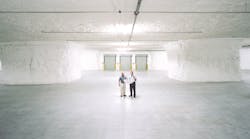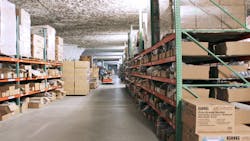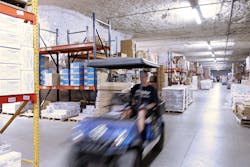First you have to consider what Kansas City has on its surface.
“It has the best interstate system for the size of the town,” says Fred Jobe, general manager at Rogers Sporting Goods. “We can ship anywhere in the U.S. in three days from here. The SubTropolis is also adjacent to the FedEx and UPS terminals. Because Rogers is one of several ecommerce tenants there’s a cluster effect and therefore more business for UPS and FedEx because of that. They’re in here so much you could get four pickups a day if you wanted. And the competition for your business is fierce here.”
It also helps that Rogers’ taxes are a third of what they would be on the surface and having a steady temperature underground comes free. Jobe estimates his operating costs are 60-70% of what they were above ground.
“Nobody’s cell phones work underground,” Jobe says. “That distraction was a battle I fought all the time when we were outside. You don’t have employees checking their phones for text messages here. Plus, anytime you have inclement weather it’s always a huge distraction above ground. Pull times go up and productivity goes down and that’s minimized here. It’s never too hot or cold.”
There are a few drawbacks, however. Storage height restrictions are number one.
“It creates a bigger footprint and that means a little slower pick time,” Jobe says.
However, Jobe has found a way for order pickers to cover all that area faster than they could with forklifts. Golf carts.
“My guys all ride golf carts but if we have a lot of big items we’ll use a forklift to pull orders,” Jobe continues. “But most of our items are not real heavy and the golf carts are real efficient as far as speed goes. Plus, you can buy five or six used golf carts for what one forklift costs.”There are other challenges besides height restrictions, but these were caused more by a technology learning curve rather than anything structural.
“Moving here, it was also our first WMS, and our first integration with our point of sale software,” he explains. “We’ve been in the e-commerce business for eight years now. When we moved down here two and a half years ago we were manually generating orders to send to the warehouse. There were no electronics involved with helping to pull the orders. Our people were just going to where they thought the product was and looking for it. Then we got WMS software with RF scanners. It was a big move for us. The system (Scout from DCT Solutions) uses sensors on the ceiling. We’re using RF guns, and with the pillars we’re using every bit of height we can. That means we needed more of those sensors for the wireless pickup points.”
Rogers plans to lease a larger adjacent space in the SubTropolis and will map the warehouse to better incorporate it into their order fulfillment plan—something Jobe wishes they had done before.
Will forklifts play a bigger role in their new space? Jobe doesn’t see why—at least for now.
“We haven’t had accidents with the golf carts and they’re easy to maintain,” he says. “We don’t multi-pick too much. We make too many mistakes when a guy has six or seven orders to pick. That’s a weakness in our software that allows those mistakes. But our picking accuracy is good. I know we’ve given up efficiency by not allowing much multi picking. We have eight order pullers but the two guys who run the shipping stations do the multi-picking. People have to earn our confidence to do that.”
There’s plenty of room for Rogers and the other tenants of the SubTropolis to grow. Right now their collective business takes up almost 6 million sq ft of space. That leaves another 8.3 million sq ft available for development. But the Rogers experience offers a better example of the need for growth in other areas where labor is concerned: the growth and nurturing of warehouse talent. MH&L has addressed the challenges of managing millennials in the workplace before, and their dependence on social media (almost to distraction in many cases) is one that Jobe seems to have conquered by making good use of the underground’s smartphone silence. Now all he has to do to further develop his logistics technology strengths is to channel his people’s hunger for telecommunications into something more business grounded.









